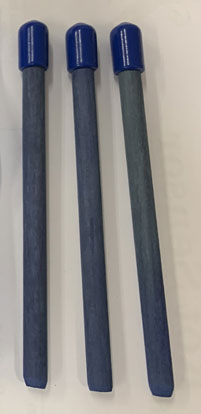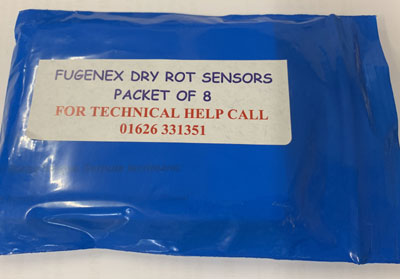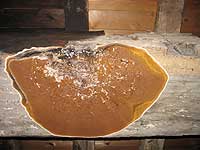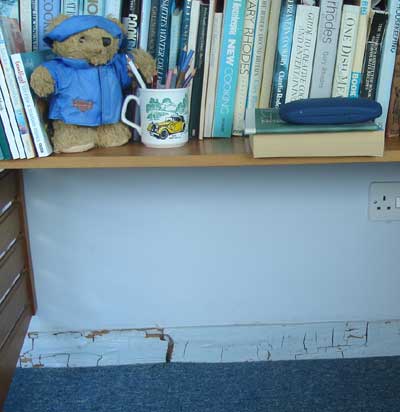Dry Rot Sensors detect Dry Rot in joists.
The sensor stick changes colour, giving advanced warning that investigation is required before damage is done.
Use our Dry Rot Sensors for detection of Dry Rot in wood, stone, brick, plaster. The colour change is easily detected. Monitor a treated area or insert into an at risk damp area.
This saves valuable building materials and unnecessary expensive chemical treatments.
Click here to see Dry Rot Sensors, check prices or order in our Dry Rot Shop
What is the Dry Rot Sensor Stick?
* a simple to install treated wooden dowel that changes colour, from blue to yellow, in the presence of active Dry Rot


What does a Dry Rot Sensor do for me?
* it allows you to tell if Dry Rot is present at its earliest stages, in timber or masonry, giving you an early warning that treatment is required before your building is damaged
How is a Dry Rot Sensor installed?
* by drilling an 8mm diameter hole to a depth of 110mm in the 'at risk' timber or masonry
How does a Dry Rot Sensor work?
* the blue detector dye, that is vacuum impregnated into the wooden stick, reacts to the chemical that Dry Rot produces, oxalic acid, at very low levels, turning the dye to yellow
Click here to see Dry Rot Sensors, check prices or order in our Dry Rot Shop
Dry Rot and other Wood Rotting Fungi
There are two main types of wood rotting fungi that attack damp timber in buildings, Wet rots and Dry rot.
To buy rot treatment you need to know the difference between a variety of Wet rots and the unique Dry rot fungus, (Dry rot Latin name - Serpula lacrymans).
This is because Dry rot can travel across dry areas made of any material to reach untreated wood to eat. Wet rots are confined to the wet areas only.
However, areas of Wet rot that dry out can easily turn into Dry rot, as the dampness level falls into the range that Dry rot prefers.
We provide Free Advice and Details of your Local Specialist to make sure that the diagnosis of Rot is correct and that we offer the correct chemical treatment for wood preservation and masonry (e.g. brick, stone, mortar) sterilisation.
All wood rots indicate a dampness problem. Damp in walls, floors and roofs must be tracked back to source and the cause of the damp treated (see www.dampness-info.co.uk).
Rots are woodland fungi frequently found in houses and commercial buildings where dampness has entered, usually as the result of leaking gutters, downpipes, drains or roofing.
They requires an initial moisture content of about 18% in wood, but Dry rot, unlike the family of Wet Rots, can spread across dry areas and across surfaces treated with wood preservatives.
This ability, unique to Dry Rot, to travel outside of the damp area makes it dangerous to wood in buildings.
You can treat masonry and timbers with wood preservatives to perfection, but a small pocket of Dry Rot can still be capable of emerging across the treated area looking for new timber to attack.
Sometimes such an outbreak can emerge long after initial treatment, as the result of a new leak into the treated area.
The treatment chemical is then over diluted by the water added from the new leak.
This dilution effect occurs because Rot treatments have to be water soluble in order to penetrate damp masonry and timber.
Dry Rot spreads in walls and floors for many months or years before symptoms become visible.
The symptoms can include Strands (like a plant root), Mycellium (a skin-like growth) or a Fruiting Body (the mushroom or Sporaphore).
Surveyors can only see the surface symptoms and cannot predict the extent of a Dry Rot attack.
This leads to extensive ripping out of sound building materials in order to be sure that the fungal attack has all been found.
The Dry Rot Stick or Sensor allows accurate diagnosis of Dry Rot and prevents Wet Rots from being misdiagnosed as Dry Rot.
The stick simply changes colour from Blue to a blotchy yellow where active Dry Rot is present.
Sticks that have not changed colour can be left in place for long term monitoring, or moved to a new position.
Click here to see Dry Rot Sensors, check prices or order in our Dry Rot Shop
The advantages of Dry Rot Sensor Sticks:
* physical colour change proof of Dry Rot eliminates 'cowboy' selling by unqualified Contractors
* D.I.Y. - easy to fit, easy to check, be your own expert
* detects early signs, before they are visible and have caused more damage
* tested by Universities in Sweden and the UK
* moisture readings can be taken off the stick with our Damp Meter
Click here to see Dry Rot Sensors, check prices or order in our Dry Rot Shop
How to treat and eradicate Dry Rot
1. Eliminate the moisture source and establish the extent by drill testing
2. Remove all decay back to sound timber.(Note - no need to cut back and scrap good wood))

Fruiting Body of Dry Rot - note the red spore dust
Click here to see Dry Rot Sensors, check prices or order in our Dry Rot Shop
Example of Dry Rot Treatment on Site

Skirting Board being eaten by Dry Rot - could have been
detected early with a Dry Rot Sensor installed.
Speak to our Experts - on 01626 872886
Click here to see Dry Rot Sensors, check prices or order in our Dry Rot Shop
Care of H S Hire, Broadmeadow Industrial Estate,
Teignmouth, TQ14 9AE
T: 01626 872886
E: help@propertyrepairsystems.co.uk
Home | Repairs | Bower Beams | Privacy Policy | Returns Policy | Contact
Use any of our Shopping Pages to place goods in your Shopping Cart - they all use the same Shopping Cart system.

Click to view your Shopping Cart
or continue shopping by clicking on one of our Shops below.
OUR CLOSELY RELATED SHOPPING PAGES
OUR OTHER SHOPPING PAGES
Other Property Repair Systems Sites:
www.drywallandfloor.co.uk - membranes for lining damp walls, floors, basements and cellars
www.epoxy-info.co.uk - epoxy resins for repairing wood, concrete, brick and stone
www.fire-door-paint.co.uk - upgrade doors to 30 minutes fire resistance
www.propertyrepairsystems.co.uk - our Home Site
www.steel-fire-paint.co.uk - treat steel with Intumescent Paint to provide fire protection
www.timber.org.uk - systems of repair, with step by step methods
www.timber-repair.co.uk - how to repair timber beams
Site written by: David Moore
David Moore, B.A. (Hons.), C.T.I.S., C.R.D.S. Technical Author
Google+